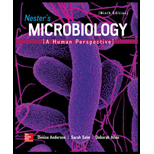
Concept explainers
Name and describe the three areas of taxonomy.
To review:
The three areas of taxonomy.
Introduction:
A group of organisms with the same properties (that is shared characteristics features and morphology) are grouped together to separate them from the ones which carry different properties. The sorting of living organisms in different groups is taxonomy and a particular group of an organism is known as a taxon (plural for which is taxa).
Therefore, taxonomy (the word taxonomy means arrangement) is the science of naming, defining and characterizingbiological organisms into hierarchical groups (taxa) based on their shared characteristics.
Explanation of Solution
In order to simplify the understanding of taxonomy, one can say that living organisms sharing same characteristics are grouped together, these groups are called taxa. Moreover, these taxa (groups) are provided with a particular rank which is called taxonomic rank. These groups of particular rank can be combined to form a higher rank, which in turn generates a taxonomic hierarchy.Therefore, one can say that taxonomy revolves around three inter-related areas of study, which is described as under-
Identification: The process of identification involves looking for basic characteristics of an organism in order to recognize it.
Classification: Once an organism is identified, the next step is to find the characters it shares with other groups and place this organism under its related group. This process of arrangement of an organism into their related group for ease of study is called classification.
Nomenclature:It can simply be defined as the naming of the organism. As a specific scientific name is assigned to an organism and that name is accepted universally, it gets easier to refer to that organism anywhere across the globe, without linguistic barriers. The scientific community follows a binomial nomenclature, in which there are two parts of the name which is written in italics. The first partof the name indicates the genus of the species, while the second part depicts the species within the genus.
There are several organisms present on this Earth, studying them becomes essential for an individual in order to know their properties. Such vast number of organisms need to be named for making the study easier, also there should be one common or universal name of an organism across the globe so that anyone can identify it without a linguistic barrier. For this purpose, the study of taxonomy was introduced which can be divided into three inter-related areas namely- identification, classification,and nomenclature.
Want to see more full solutions like this?
Chapter 10 Solutions
Nester's Microbiology: A Human Perspective
- Describe the principle of homeostasis.arrow_forwardExplain how the hormones of the glands listed below travel around the body to target organs and tissues : Pituitary gland Hypothalamus Thyroid Parathyroid Adrenal Pineal Pancreas(islets of langerhans) Gonads (testes and ovaries) Placentaarrow_forwardWhat are the functions of the hormones produced in the glands listed below: Pituitary gland Hypothalamus Thyroid Parathyroid Adrenal Pineal Pancreas(islets of langerhans) Gonads (testes and ovaries) Placentaarrow_forward
- Describe the hormones produced in the glands listed below: Pituitary gland Hypothalamus Thyroid Parathyroid Adrenal Pineal Pancreas(islets of langerhans) Gonads (testes and ovaries) Placentaarrow_forwardPlease help me calculate drug dosage from the following information: Patient weight: 35 pounds, so 15.9 kilograms (got this by dividing 35 pounds by 2.2 kilograms) Drug dose: 0.05mg/kg Drug concentration: 2mg/mLarrow_forwardA 25-year-old woman presents to the emergency department with a 2-day history of fever, chills, severe headache, and confusion. She recently returned from a trip to sub-Saharan Africa, where she did not take malaria prophylaxis. On examination, she is febrile (39.8°C/103.6°F) and hypotensive. Laboratory studies reveal hemoglobin of 8.0 g/dL, platelet count of 50,000/μL, and evidence of hemoglobinuria. A peripheral blood smear shows ring forms and banana-shaped gametocytes. Which of the following Plasmodium species is most likely responsible for her severe symptoms? A. Plasmodium vivax B. Plasmodium ovale C. Plasmodium malariae D. Plasmodium falciparumarrow_forward
- please fill in missing parts , thank youarrow_forwardplease draw in the answers, thank youarrow_forwarda. On this first grid, assume that the DNA and RNA templates are read left to right. DNA DNA mRNA codon tRNA anticodon polypeptide _strand strand C с A T G A U G C A TRP b. Now do this AGAIN assuming that the DNA and RNA templates are read right to left. DNA DNA strand strand C mRNA codon tRNA anticodon polypeptide 0 A T G A U G с A TRParrow_forward
 Concepts of BiologyBiologyISBN:9781938168116Author:Samantha Fowler, Rebecca Roush, James WisePublisher:OpenStax College
Concepts of BiologyBiologyISBN:9781938168116Author:Samantha Fowler, Rebecca Roush, James WisePublisher:OpenStax College Biology Today and Tomorrow without Physiology (Mi...BiologyISBN:9781305117396Author:Cecie Starr, Christine Evers, Lisa StarrPublisher:Cengage Learning
Biology Today and Tomorrow without Physiology (Mi...BiologyISBN:9781305117396Author:Cecie Starr, Christine Evers, Lisa StarrPublisher:Cengage Learning Biology 2eBiologyISBN:9781947172517Author:Matthew Douglas, Jung Choi, Mary Ann ClarkPublisher:OpenStaxCase Studies In Health Information ManagementBiologyISBN:9781337676908Author:SCHNERINGPublisher:Cengage
Biology 2eBiologyISBN:9781947172517Author:Matthew Douglas, Jung Choi, Mary Ann ClarkPublisher:OpenStaxCase Studies In Health Information ManagementBiologyISBN:9781337676908Author:SCHNERINGPublisher:Cengage Human Heredity: Principles and Issues (MindTap Co...BiologyISBN:9781305251052Author:Michael CummingsPublisher:Cengage Learning
Human Heredity: Principles and Issues (MindTap Co...BiologyISBN:9781305251052Author:Michael CummingsPublisher:Cengage Learning





